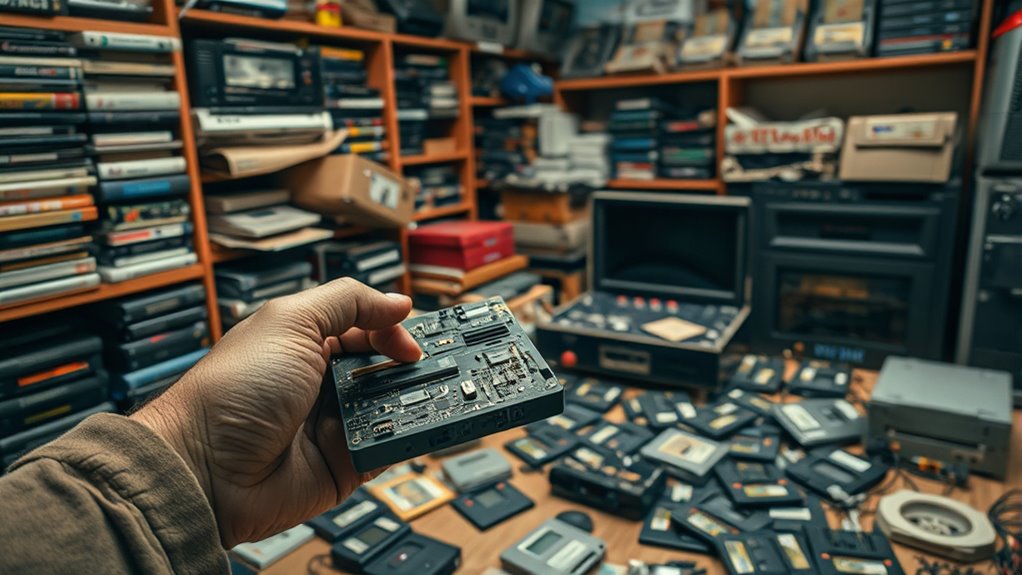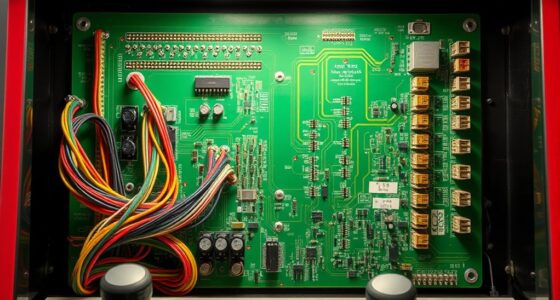Preservation efforts involve carefully dumping ROMs from original hardware using specialized tools and hardware, then emulating the games on software like RetroArch or Dolphin. This process helps safeguard classic titles from hardware decay or obsolescence while respecting legal and ethical boundaries by using legitimate copies. By backing up and archiving these ROMs securely, you guarantee future access. If you want to explore the detailed steps and best practices, there’s much more to discover.
Key Takeaways
- Proper dumping of ROMs involves careful hardware disassembly, using compatible tools, and verifying data integrity to preserve original game data ethically.
- Emulation benefits from reliable software, BIOS configurations, and high-performance hardware to accurately replicate vintage gaming experiences.
- Digital preservation efforts are supported by community collaboration, metadata organization, and secure cloud backups to prevent data loss.
- Ethical preservation emphasizes using legitimate copies, respecting copyright laws, and avoiding unauthorized ROM sharing.
- Future trends include automation, blockchain-backed backups, and broader community initiatives to document and archive rare titles.
The Significance of Digital Preservation for Classic Games
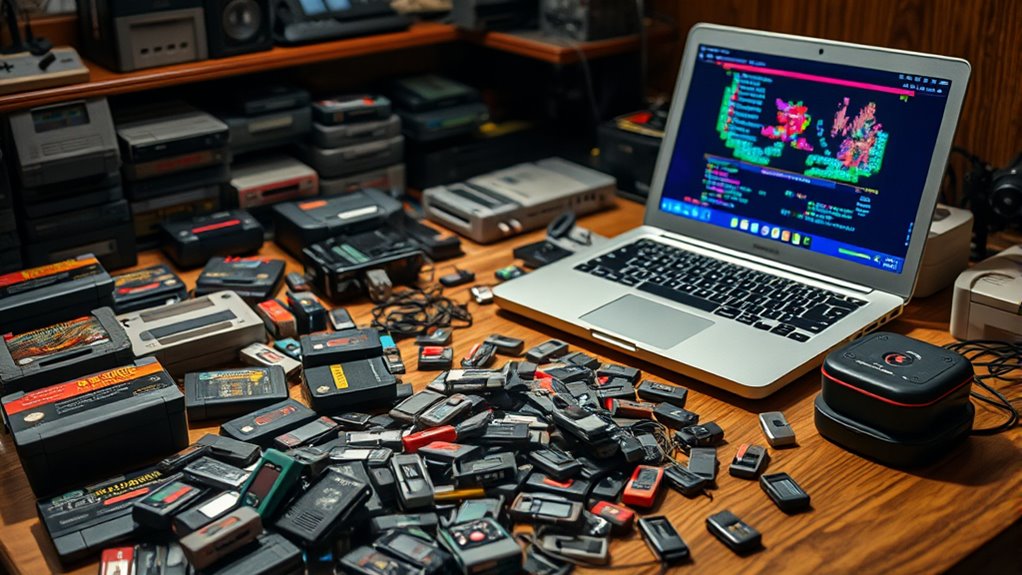
Why is digital preservation so important for classic games? It ensures that these timeless titles aren’t lost to time, hardware decay, or obsolescence. Digital archiving plays a crucial role by securely storing game data, making it accessible for future generations. Cloud backups add an extra layer of security, protecting your collection from physical damage or tech failures. By maintaining high-quality copies in digital archives, you preserve the gameplay experience and cultural significance of these classics. Without proper preservation efforts, valuable gaming history risks fading away forever. Taking steps like digital archiving and utilizing cloud backups helps you safeguard these games, ensuring they remain playable and appreciated long into the future. Preservation isn’t just about nostalgia; it’s about protecting a digital culture that continues to evolve and influence new generations.
Technical Steps in Dumping ROMS From Original Hardware
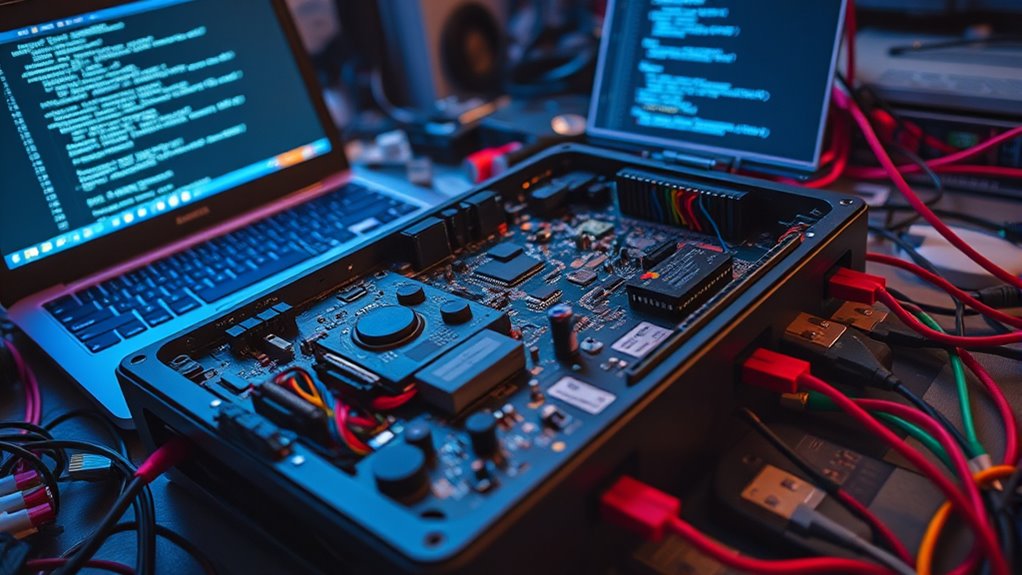
To start dumping ROMs from original hardware, you need specific tools and hardware setups. You’ll disassemble the device carefully and connect it to your extraction equipment. Once connected, you can proceed with the data extraction process to save the game data accurately. Proper family background understanding can also help in handling sensitive equipment with care.
Hardware Requirements Needed
Before you start dumping ROMs from original hardware, you’ll need to gather specific equipment. Making sure hardware compatibility is crucial; incompatible devices can damage your hardware or produce poor quality dumps. You’ll also need suitable storage mediums like SD cards, USB drives, or external HDDs, depending on your setup. Here’s a quick overview:
| Hardware Type | Compatibility Tips | Storage Options |
|---|---|---|
| USB Adapter | Check port types | USB flash drives |
| Flasher Devices | Confirm console support | SD cards, external HDDs |
| Cables | Use quality cables | N/A |
Matching the right hardware ensures smooth dumping and safe storage of your ROMs. For optimal results, understanding the Self Watering Plant Pots can be analogous to choosing the correct hardware components, as both require proper setup to function effectively.
Disassembly and Connection
Start by carefully disassembling your device to access the internal components where the ROM is stored. Use proper disassembly techniques to avoid damaging delicate parts, removing screws and casing panels methodically. Once inside, identify the chips or memory modules that contain the ROM. To establish a connection, familiarize yourself with the device’s connection protocols—these can vary from simple pinouts to complex serial interfaces. Verify you have the correct tools, such as clip adapters or soldering equipment, to connect your reader or programmer securely. Maintain a steady hand to avoid static or electrical issues. Proper disassembly and understanding of connection protocols are vital for safely accessing and preparing the ROM for dumping without compromising the hardware’s integrity. Additionally, understanding the device’s power requirements is essential to prevent issues during the process.
Data Extraction Process
How do you accurately extract the data from the ROM without corrupting or damaging it? First, guarantee hardware compatibility between your extraction device and the original hardware. Use a reliable programmer or reader designed for the specific type of ROM chip to prevent data corruption. Connect carefully during disassembly, avoiding static discharge and mechanical stress. Before starting, verify the integrity of your equipment to maintain data integrity throughout the process. Use proper software tools to read the data, and save multiple copies to safeguard against errors. Always double-check the extracted files for consistency. Following these steps helps preserve the original data, reduces risk of damage, and guarantees a faithful digital copy for emulation or archival purposes. Additionally, understanding industry trends can help you select the most effective tools and techniques for your project.
Tools and Software Used in ROM Emulation
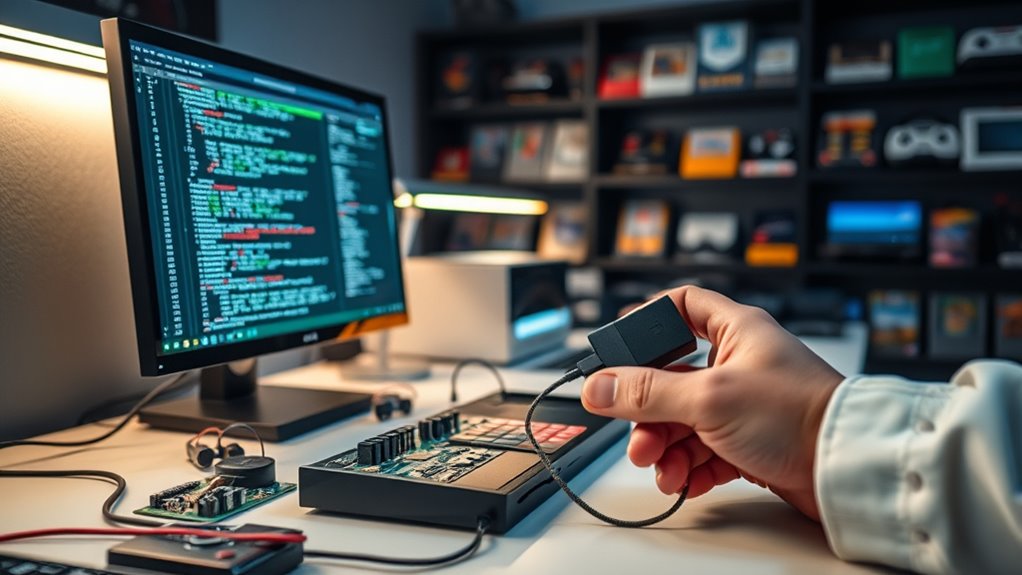
To emulate ROMs effectively, you need the right tools and software. You’ll find various emulation programs, ROM extraction utilities, and BIOS or firmware utilities that make the process smoother. Choosing the appropriate options depends on your specific needs and the systems you’re working with. Ensuring compatibility with emulation software is crucial for a successful setup.
Emulation Software Options
Have you ever wondered what software makes ROM emulation possible? There are several options available that cater to different needs. Popular emulators like RetroArch, Dolphin, and PCSX2 offer robust features, including save states, which let you save and load your game progress instantly. They also support cheat codes, enhancing gameplay or accessing hidden features. These tools are user-friendly and adaptable, often supporting multiple platforms and devices. Many emulators come with customizable controls and graphics enhancements, making your experience more authentic. Whether you’re a casual gamer or a preservation enthusiast, these software options provide reliable ways to run ROMs safely and efficiently. Exploring their features helps you find the best fit for your setup, ensuring your games are preserved and playable for years to come. Additionally, emulation software can often be configured to emulate specific hardware environments, further improving compatibility and performance.
ROM Extraction Tools
ROM extraction tools are the backbone of preparing game files for emulation, enabling you to create digital copies from physical media or existing files. These tools vary in hardware compatibility, supporting different consoles, disc formats, and storage devices. Some require specialized hardware, like cartridge readers or disc drive interfaces, while others operate solely on your computer. When choosing extraction software, consider licensing terms, as many are open-source or free, but some commercial options may have restrictions. Properly retrieving ROMs ensures you preserve the original data accurately and maintain legal compliance. Using the right tools streamlines the process, reduces errors, and guarantees that your digital copies are suitable for emulation, helping you safeguard gaming history efficiently and responsibly. Additionally, understanding ROM extraction methods is essential for ensuring data integrity during the process.
BIOS and Firmware Utilities
Efficient emulation relies heavily on the proper use of BIOS and firmware utilities, which serve as the essential bridge between your hardware and software. These tools help you configure, update, and customize system firmware to guarantee compatibility and stability. BIOS customization allows you to tweak settings for peak performance or compatibility with specific ROMs, while firmware updates fix bugs and improve emulation accuracy. Using specialized utilities, you can manage BIOS images and firmware files effectively. Keep your BIOS and firmware current to prevent issues during emulation. Regular updates can also enhance system stability and overall emulation quality.
Legal and Ethical Considerations in ROM Preservation
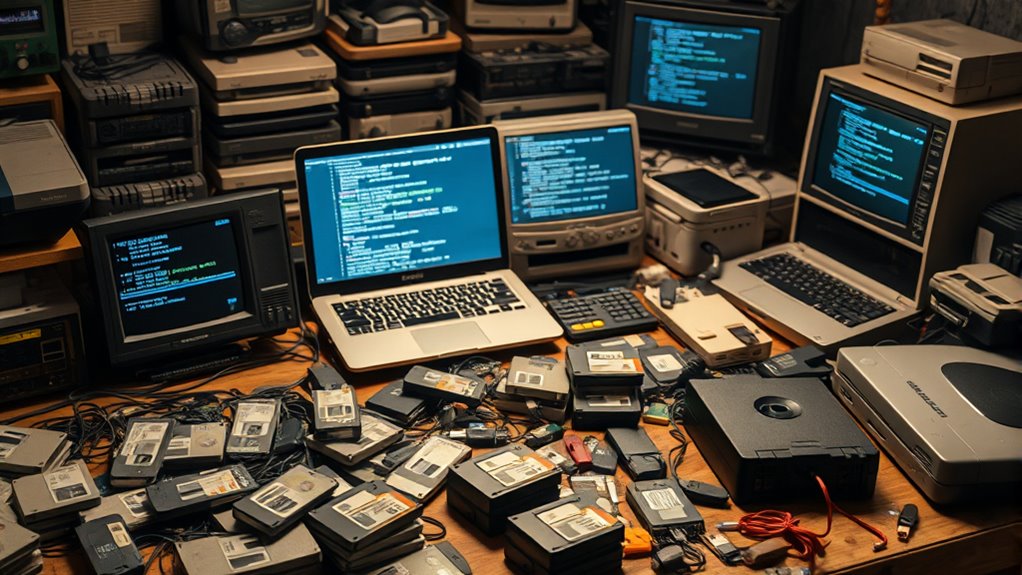
Legal and ethical considerations play a crucial role in ROM preservation, as they determine how digital content can be accessed, copied, and shared. You need to be aware of copyright concerns that restrict unauthorized distribution or duplication of protected material. Respecting intellectual property rights is essential to avoid legal repercussions and support creators’ moral responsibilities to protect their work. While preserving ROMs can help maintain gaming history, doing so without proper authorization raises ethical questions. It’s important to balance preservation efforts with respect for legal boundaries. You should seek legitimate copies or use open-source and public domain resources whenever possible. Upholding these principles ensures your preservation activities are responsible, lawful, and respectful of the rights held by content creators. Additionally, awareness of AI security vulnerabilities is important to understand potential risks associated with digital preservation tools and methods.
The Role of Archiving and Storage Solutions
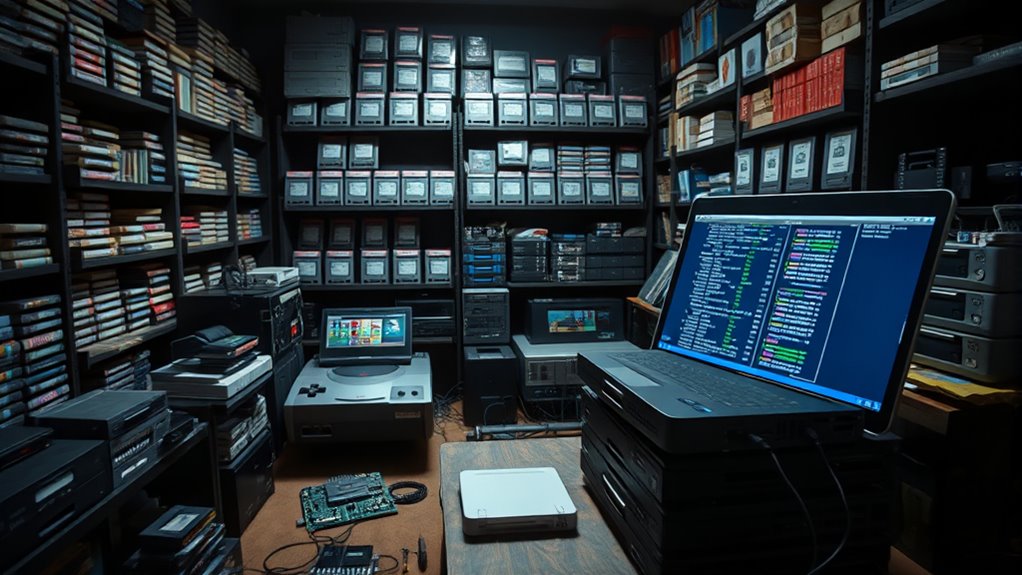
Effective archiving and storage solutions are vital to guaranteeing the longevity and accessibility of digital content. You need reliable methods like cloud storage to safeguard ROMs and related files, providing scalable and off-site backup options. Metadata management helps you organize and retrieve assets efficiently, making long-term preservation feasible. Consider these key points:
Reliable cloud storage and metadata are essential for long-term digital content preservation and easy access.
- Cloud storage offers redundancy and easy access across devices
- Metadata enhances searchability and contextual understanding
- Regular backups prevent data loss from hardware failures
- Proper categorization ensures future-proof retrieval and management
Challenges and Limitations of Emulation Technology
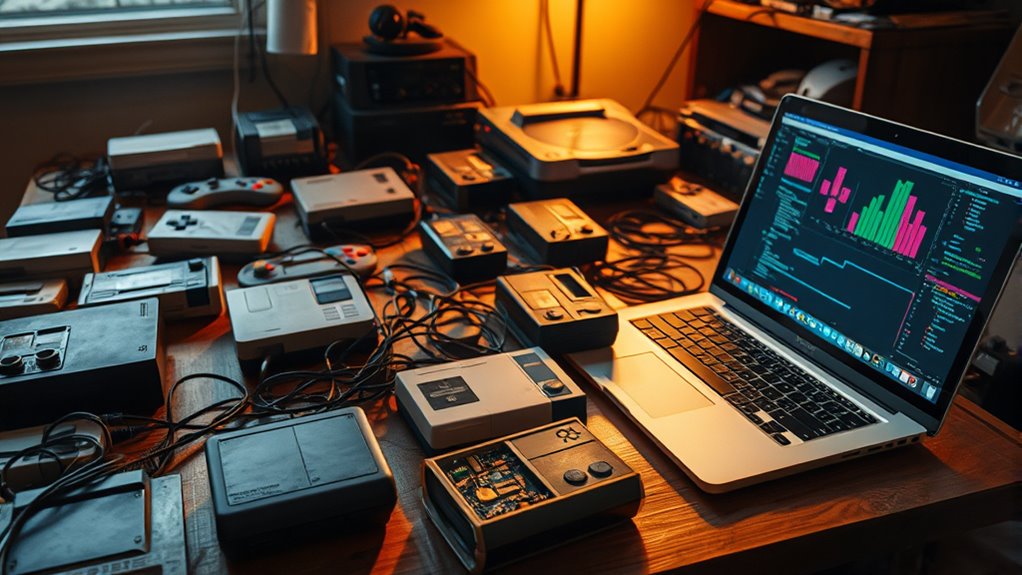
While emulation technology has made it possible to run classic games and software on modern devices, it faces several significant challenges. Hardware limitations can hinder performance, causing slowdowns or glitches that weren’t present on original hardware. Some systems require high processing power or specialized components that aren’t easily replicated in emulators. Software incompatibilities also pose issues, as certain games or applications rely on hardware-specific features or behaviors that emulators struggle to reproduce accurately. This can lead to bugs, missing graphics, or audio glitches that diminish the experience. Additionally, emulation often demands technical expertise to configure properly, making it less accessible for casual users. These challenges highlight that, despite advancements, emulation still isn’t a perfect substitute for original hardware.
Community Contributions to Game Preservation
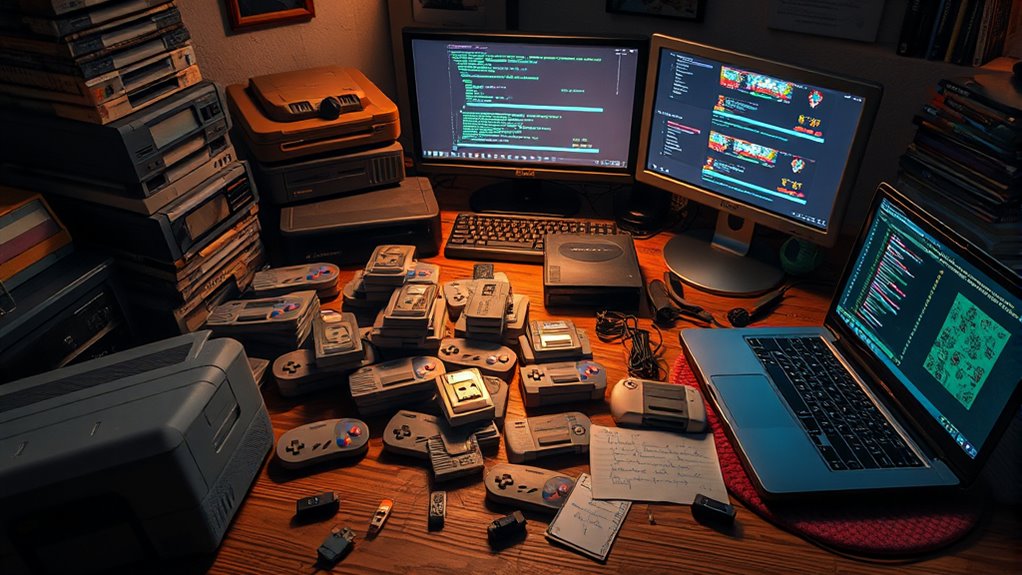
Have you ever wondered how communities play a vital role in preserving video game history? They often lead efforts in digital archiving, ensuring rare titles aren’t lost. Through community collaboration, dedicated fans share and verify ROMs, providing access to games that might otherwise fade away. These groups organize collections, document game histories, and create emulators to emulate original experiences. Their work keeps legacy titles alive for future generations. By pooling resources and knowledge, communities help fill gaps left by commercial preservation efforts. This collective effort highlights the importance of grassroots initiatives in maintaining gaming culture. Essentially, community contributions foster a sense of shared responsibility, making sure that even obscure or endangered titles are preserved and accessible for everyone.
Future Trends in Digital Preservation and Emulation
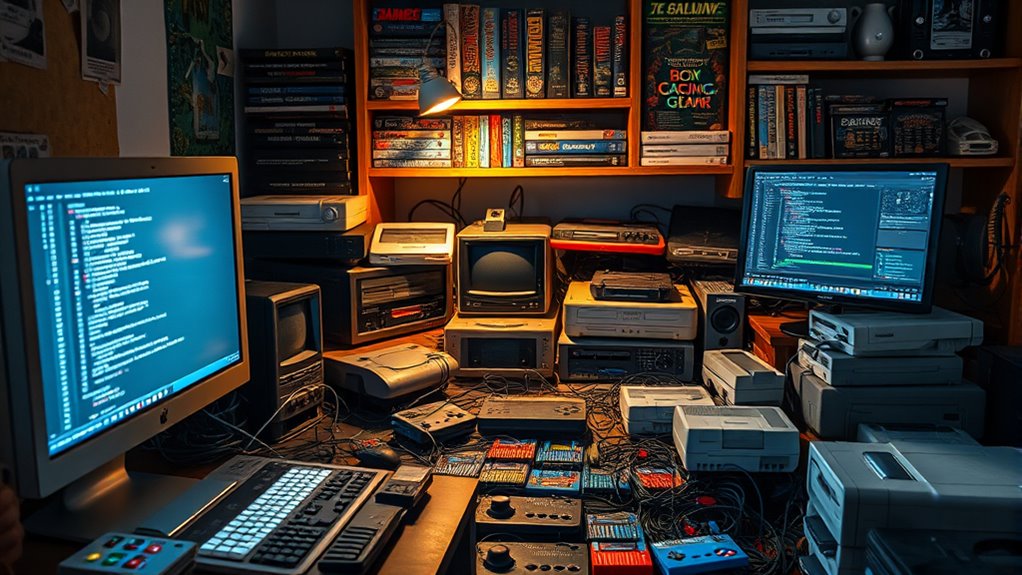
As technology advances, the future of digital preservation and emulation is poised to become more innovative and accessible. Cloud preservation will play a key role, allowing you to store vast collections securely and remotely, making recovery faster and more reliable. Additionally, blockchain backups will enhance data integrity and provenance, ensuring your preserved ROMs and emulation environments remain tamper-proof. These technologies will facilitate collaboration across institutions, enabling shared access while maintaining authenticity and transparency. You’ll also see improved automation tools that streamline the preservation process, reducing manual effort and minimizing errors. Overall, these trends will make digital preservation more resilient, scalable, and user-friendly, helping you safeguard gaming history and software heritage for generations to come.
Frequently Asked Questions
How Do ROM Dumping Methods Vary Between Different Consoles?
You’ll find that ROM dumping methods differ between consoles due to console-specific techniques and hardware compatibility. For example, some systems require specialized hardware or exploits to access their memory, while others allow direct reading via USB or SD card. Understanding these differences helps you choose the right approach, whether using hardware tools or software exploits, ensuring successful ROM extraction tailored to each console’s unique architecture.
What Are Common Hardware Failures During ROM Extraction?
Think of your console as a fragile bridge, vulnerable to hardware degradation over time. During ROM extraction, you might encounter connector issues that hinder data transfer or cause damage. These hardware failures can lead to corrupted dumps or permanent loss of data. Carefully handling components, checking connections, and avoiding static can help you prevent such failures, ensuring your digital treasures stay intact for future generations.
How Can I Verify the Integrity of Dumped ROMS?
To verify the integrity of dumped ROMs, you should perform checksum verification using tools like MD5 or SHA-1. These checksums compare the file’s hash to the original, ensuring it hasn’t been corrupted during dumping. Regularly checking file integrity helps confirm that your ROMs are accurate and unaltered, giving you confidence that your backups are reliable and authentic for preservation or emulation purposes.
Are There Risks of Data Corruption During Emulation?
Imagine your data as a delicate thread weaving through time. During emulation, risks of data corruption can threaten this thread, impacting backup reliability and emulation accuracy. You must be vigilant, ensuring your systems are stable and your files are verified. By maintaining proper backups and choosing reliable emulation tools, you safeguard this thread, preserving the integrity of your digital memories against the unpredictable winds of corruption.
How Do Community Projects Ensure Long-Term Preservation?
Community projects guarantee long-term preservation by actively engaging in community archiving, where members collaborate to catalog and maintain digital assets. They prioritize digital sustainability by using open formats and reliable storage solutions, making certain data remains accessible over time. You can support these efforts by contributing resources, sharing knowledge, and advocating for practices that protect digital history, helping to preserve gaming and software heritage for future generations.
Conclusion
As you explore the world of ROM dumping and emulation, imagine stepping into a vast digital archive, where every pixel and sound is preserved like a fragile relic. By actively participating in preservation efforts, you help keep classic games alive, allowing others to experience their magic. Embrace the tools and community behind this movement, knowing you’re part of a vibrant effort to safeguard gaming history—ensuring these timeless worlds continue to inspire future generations.
